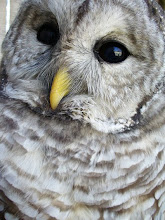First, the projects: if you stop by the park, you may notice that we’re under construction yet again! While construction offers a host of interesting problems to overcome when the site is surrounded by sensitive species and permanently non-releasable birds of prey, we are very excited about the result: four new free-loft pens, a new trail, and a brand-new ‘off display’ area for the birds to get a rest in between public appearances. Special thanks to Conservation Halton’s dedicated construction team, our own incredible volunteers and staff who are working alongside them, and the donors who made this possible in the first place!

These new mews are replacing old and worn-down tethering places, and are certainly an improved use of the space. We’ll let you know when construction is complete and the birds have moved in!
Other exciting and upcoming projects include an Osprey Cam on our osprey tower, ready to catch next year’s breeding season. Our Osprey are an important part of our park, and a pair has been nesting continuously on the Mountsberg Reservoir for more than 15 years. Our last Osprey Cam was hit by lighting in 2000, so after 10 years we’re excited for the chance to closely observe this fantastic and unique Ontario raptor.
As for our new permanent residents? We have welcomed three in the past few weeks: "Freeway", a one-eyed red-tailed hawk who survived her injuries after being hit by a truck on Hwy. 402. Freeway, who came from Salthaven Wildlife Rehabilitation Centre with the help of the Ontario Ministry of Natural Resources, is a young bird who is settling in nicely, but still has much to learn about adapting to her new visual limitations.
 Two captive-bred owls have joined us as well— "Cedar", a long-eared owl, and "Sage", a short-eared owl. These owls are in training currently, and we hope they will be able to join the Education Team in the spring. If you’re lucky, you may catch a glimpse of them if you book a Raptor Encounter Program!
Two captive-bred owls have joined us as well— "Cedar", a long-eared owl, and "Sage", a short-eared owl. These owls are in training currently, and we hope they will be able to join the Education Team in the spring. If you’re lucky, you may catch a glimpse of them if you book a Raptor Encounter Program!Wishing all of our readers an excellent and safe holiday season—if you’re looking for something to do, we hope you drop by! Mountsberg Conservation Area’s gates are open every day except Christmas Day (Dec. 25th), and the Raptor Centre has shows at 12pm and 2pm every day between December 25th and New Year’s Day.
See you on the trails!
See you on the trails!














